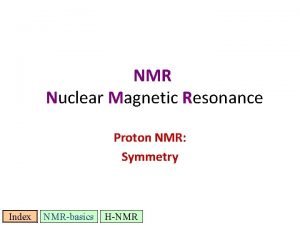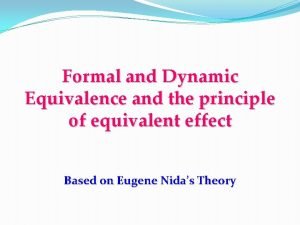Equivalence of the Two Statements Thermodynamics II Assistant






- Slides: 6

Equivalence of the Two Statements Thermodynamics II Assistant Professor Dr Ahmed Majhool **Proof that the violation of the Kelvin–Planck statement leads to the violation of the Clausius statement. The Kelvin–Planck and the Clausius statements are equivalent in their consequences, and either statement can be used as the expression of the second law of thermodynamics. Any device that violates the Kelvin–Planck statement also violates the Clausius statement, and vice versa.

REVERSIBLE AND IRREVERSIBLE PROCESSES Reversible process: A process that can be reversed without leaving any trace on the surroundings. Irreversible process: A process that is not reversible. Thermodynamics II Assistant Professor Dr Ahmed Majhool All the processes occurring in nature are irreversible. Why are we interested in reversible processes? (1) they are easy to analyze and (2) they serve as idealized models (theoretical limits) to which actual processes can be compared. Some processes are more irreversible than others. We try to approximate reversible processes. Why? Reversible processes deliver the most and consume the least work.

Friction renders a process irreversible. The factors that cause a process to be irreversible are called irreversibilities. They include friction, unrestrained expansion, mixing of two fluids, heat transfer across a finite temperature difference, electric resistance, inelastic deformation of solids, and chemical reactions. The presence of any of these effects renders a process irreversible. Thermodynamics II Assistant Professor Dr Ahmed Majhool Irreversibilities (a) Heat transfer through a temperature difference is irreversible, and (b) the reverse process is impossible. Irreversible compressio n and expansion processes.

Internally and Externally Reversible Processes Thermodynamics II Assistant Professor Dr Ahmed Majhool Internally reversible process: If no irreversibilities occur within the boundaries of the system during the process. Externally reversible: If no irreversibilities occur outside the system boundaries. Totally reversible process: It involves no irreversibilities within the system or its surroundings. A totally reversible process involves no heat transfer through a finite temperature difference, no nonquasi-equilibrium changes, and no friction or other dissipative effects. 4

THE CARNOT CYCLE Thermodynamics II Assistant Professor Dr Ahmed Majhool Execution of the Carnot cycle in a closed system. Reversible Isothermal Expansion (process 1 -2, TH = constant) Reversible Adiabatic Expansion (process 2 -3, temperature drops from TH to TL) Reversible Isothermal Compression (process 3 -4, TL = constant) Reversible Adiabatic Compression (process 4 -1, temperature 5 rises from TL to TH)

Thermodynamics II Assistant Professor Dr Ahmed Majhool The Reversed Carnot Cycle The Carnot heat-engine cycle is a totally reversible cycle. Therefore, all the processes that comprise it can be reversed, in which case it becomes the Carnot refrigeration cycle.











